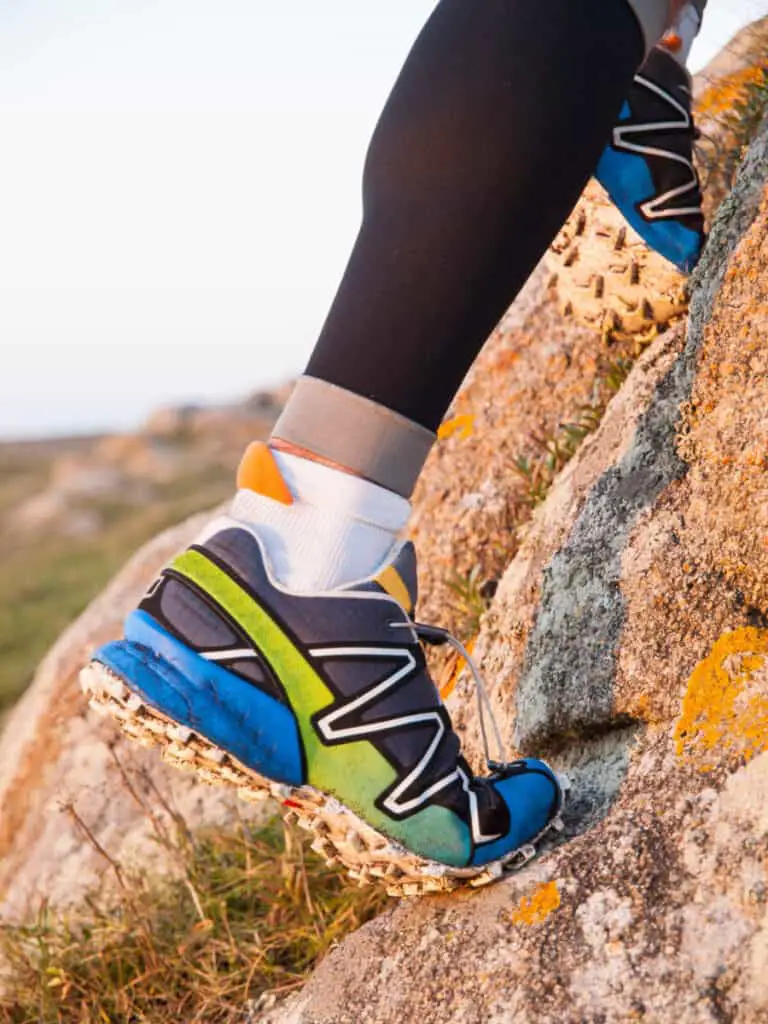
Trail running is a great exercise that has gained popularity over the years. But, because trail running can vary greatly in how challenging it is, and different people will burn calories at different rates, it’s hard to give a number for how many calories you burn in trail running.
In one hour of trail running, a person will burn anywhere from 450 calories to 900 calories depending on their speed. Of course, this can vary because of their size and how challenging the trail is. Trail running is a better workout than road running—10% more calories are burned in trail running.
There are a lot of factors that go into how many calories you burn and how good of a workout you will get while trail running. Keep reading for more info.
What Is Trail Running?
Trail running is when you run in nature on a designated trail. It is not trail running if you are on a paved road or sidewalk. Trail running is when you are out in nature, running and adapting to natural obstacles and challenges, like branches, rocks, hills, and streams. (Source )
)
Trail running is fun because you get good exercise, you are out in nature, and your body is challenged.
Trail running can be seen as a mix of running and hiking. From running you get the faster pace, and from hiking, you get the more nature-based location and rougher terrain. Some people might see trail running as just fast hiking, but it is actually pretty different in several ways.
Calories Burned
You burn a lot of calories while doing serious trail running. Of course, the number of calories you burn can fluctuate, and a lot of that depends on how challenging the terrain is and how fast you run. For example, a run with little elevation change will be less of a workout than one with consistent, dramatic hills and elevation changes.
Given all of that, it is easy to understand why there is no clear-cut answer to how many calories you will burn while trail running. Some say that you will burn an average of 450 calories an hour going 4.5 miles per hour, but you can burn an average of 900 calories if you are going 9 miles an hour. (Source )
)
It has also been said that you burn 10% more calories while trail running than normal running. (Source ) For each hour you run on a trail, you will burn an additional 60 to 90 calories. (Source
) For each hour you run on a trail, you will burn an additional 60 to 90 calories. (Source )
)
If you really want to know the exact number of calories you are burning, consider getting a watch that tracks the calories you burn. That will be a good way for you to learn how good your workout really is. As you see the benefits of trail running, your motivation to run new paths will increase.
Why Is It Such a Good Workout?
Trail running works more muscles than normal running
One of the reasons trail running is a good workout is that it works more muscles than regular road running. Because you are not running on a treadmill or a paved road, you have to deal with and adapt to the terrain. Things like rocks, roots, or steep uphills challenge you in a way running on pavement does not. It makes you use other muscles you wouldn’t normally use to keep you balanced. (Source )
)
Trail running is also more of a mental workout than road running because you cannot simply turn your brain off while trail running. You need to stay focused on the trail in order to avoid hazards, which means that you need to stay present and mindful in a way that is a little more taxing for your mind.
Variety in scenery
This reason might take a moment to explain, but a benefit of trail running as a workout is that you can change up the scenery and go running in many different locations. A lot of workouts can seem boring and monotonous after a while, but trail running is not just a workout. It allows you to be in nature, breathe the fresh air, and see some gorgeous sites. There are also many different places you could go trail running, so it is not going to be the same every single time you go. It is much harder to get bored of a workout that keeps changing scenery.

Improves balance and agility
One of the many benefits of trail running is that it improves your balance and agility. This is because of the changes in terrain and having to deal with rocks and roots that challenge your balance. Improving your balance and agility is something that will benefit you a lot.
You will also learn new running techniques as you run on trails. Running up hills will teach you what kind of incline you can handle. Running down hills will teach you to stop your body’s impulse to lengthen your stride, as doing so will stretch your muscles too much, which can cause strain and injury.
Weight loss
Because you are using a lot of muscles and burning a lot of calories, trail running leads to increased weight loss. When you run on a road, your body will do everything that it can to conserve energy and get through the run. When you get into stride while running on a road, your body is exerting itself as little as possible in order to keep going. On a trail, however, you can’t really get into stride. Your pace will adapt to the terrain, and you will constantly need to adjust how you are running.
Because of this, your body needs to work harder, leading you to lose more weight. If you have a weight loss goal, trail running will help you to reach it faster while making your runs a more enjoyable experience.
Health Benefits of Trail Running
There are lots of benefits of exercise in general, and trail running is no exception. When trail running is done right and done consistently, there are a lot of benefits that it can result in.
Physical benefits
The first benefit of trail running that most people would think of is the physical benefit. Like other workouts, consistent trail running will result in stronger, more toned muscles. Your exercise capacity can also increase, along with your balance.
Also, because so many calories are burned, trail running is good for weight loss and can help you control your weight (as discussed above).
Psychological benefit
Exercise in general does a lot for your mental health. It can help with problems like low self-esteem or a bad mood. Exercise also can help reduce the severity of a couple of mental health problems, like depression and anxiety. (Source )
)

Another thing that can positively affect your mental state is just being in nature. Being in nature can help soften your negative emotions and promote happy feelings. Also, a study showed that being outside can calm people, helping them feel less stressed, anxious, and depressed. (Source )
)
Trail running both gets you outside in nature and gets you exercising, two things that can positively affect your mental health. As you reach your goals, you will grow more confident and more able to take on new challenges. If you run mountains, there is a thrill that comes from climbing to the top that does your heart and your mind a lot of good.
Trail Running vs. Road Running
There are many different ways you can run—trail running and road running are two of them. Road running is almost the opposite of trail running. While trail running is off of paved roads or paths, road running is when you are running on a road or set path. (Source ) So, the biggest difference between the two is simple. Road running is on the more urban or paved paths, while trail running is on the dirt in nature.
) So, the biggest difference between the two is simple. Road running is on the more urban or paved paths, while trail running is on the dirt in nature.
One of the other big differences between these two types of running is their difficulty. First of all, both of these can be easy, but both of them can also be hard. It really depends on the challenge level of the path, how fast you are running, and how far you are running. Even with all of this, doing 5 miles of road running is very different from doing 5 miles of trail running.
Trail running is typically harder than road running. Trail running uses more muscles, but because of all the obstacles, it can be slower than road running.
You might be wondering, which is safer? Which are you more likely to get injured doing? This is a very complicated issue because you can get injured doing either trail running or road running.
With trail running, the terrain is uneven, and there can be unexpected obstacles, like branches hitting your head, tripping over rocks, or twisting your ankle in a concealed hole.
On the other hand, you can get injured doing road running too, it just isn’t as obvious. When road running, you are running on a hard surface, like pavement or concrete. Because of this, road running can cause injury to the knees because of impact. Trail running, on the other hand, means that you are running on dirt and gravel, either of which will absorb the impact of your steps. (Source )
)
Also, because the terrain is so consistent and repetitive on pavement, your steps are also very similar. This might not seem like a bad thing, but you are using the same muscles, taking steps the same way, all on a hard surface. These can result in overuse and stress on important muscles which can cause injuries like IBS or shin splints. (Source )
)
All in all, both activities involve risk and can be strenuous on the body. Road running’s harsh impact hurts your legs, but trail running is more likely to lead to a twisted ankle or a broken leg if you aren’t careful.
Getting the Right Gear
If you want to get into the habit of trail running, you are going to want to get the appropriate gear.
The really important thing you will want to consider getting a nice pair of trail running shoes. These shoes will have more traction to help you stay up on precarious footings like loose dirt and protruding roots. You should always make sure your shoes fit you correctly; you don’t want them too loose or too tight. Either of these extremes can result in serious discomfort and foot injuries like blisters, twisted ankles, or bruised nails. (Source )
)

In addition to giving you more traction, trail running shoes should also have thicker soles. These soles will protect you from rocks and gravel on the path you are running, which will keep your feet in a condition where you can keep running. If you don’t have thick soles, trail running will be a miserable experience where every step causes you discomfort or pain.
Running on trails can mean higher elevation and colder temperatures, so be sure to layer up for the kind of weather you will be facing. As always, find clothing that will wick away the sweat from your skin while keeping your body’s temperature at appropriate levels. If it is your first time running in an area, do some research to find out what kind of temperatures you will be facing.
Some other things that you might want to consider getting are trail maps, GPS watches or trackers, or something else to help you in case you get lost. It’s a smart idea to always have a cell phone with you. This is a good safety precaution in case you get hurt or lost on the trail, both of which can be real concerns in trail running. It is also to know whether or not you will have cellular service in the area where you are running. Having a cell phone isn’t very helpful if you can’t use it to reach anyone.
Another thing to consider getting is a watch that tracks how many calories you burn while running. There are a few different watches that have these capabilities. Some that are available are Apple watches, FitBits, Garmen, or Polar RS300X. These watches can be very useful, but also expensive. (Source )
)

